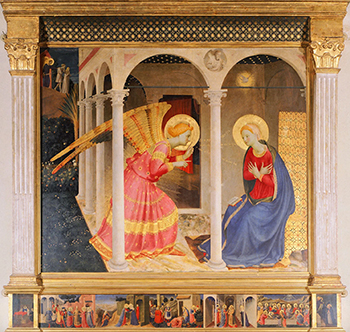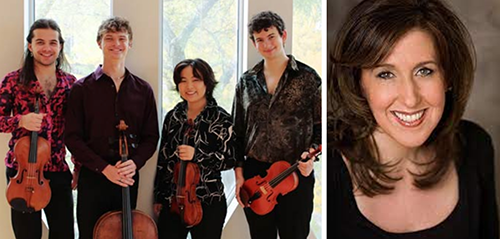by Daniel Hathaway
Two events are on the agenda at 7:30 this evening.
In Gamble Auditorium at Baldwin Wallace, faculty mezzo soprano Nancy Maultsby will join the Poiesis Quartet in Cleveland Orchestra trombonist Richard Stout’s Songs Of Correspondence, and Poiesis will play faculty composer Clint Needham’s String Quartet No. 2.
And on Jeffrey Mumford’s Signature Series at Lorain County Community College’s Studio Theater in Elyria, solo violist Jordan Bak will be featured in a program ranging from J.S. Bach and Telemann to Vieuxtemps, Mumford, Tyson Davis, and Anne Leilehua Lanzilotti.
For details of these and other events, visit our Concert Listings.
SEASON ANNOUNCEMENT:
Encore Chamber Music Institute has announced programs for its ninth Gates Mills Music & Ideas Festival. “Planet Earth” will feature classical favorites and music by Scandinavian composers paired with works by living and underrepresented composers in six venues from June 2-24. Click here for the schedule and ticket information.
A TRIO OF OBITUARIES:
Pianist Maurizio Pollini, “who won the Chopin competition at 19 and who had an intellectual approach to art and life,” has died at the age of 82. Read Barry Millington’s obituary in yesterday’s edition of The Guardian.
Gramophone writes, “The composer Peter Eötvös died at the age of 80 on March 24. As a tribute we are republishing below a fascinating overview of his life and work by Arnold Whittall, which originally appeared in the February 2017 issue of Gramophone.”
In The New York Times on March 21, Michael S. Rosenwald reported that “Amnon Weinstein, an Israeli luthier who restored violins belonging to Jews during the Holocaust so that musicians around the world could play them in hopeful, melodic tributes to those silenced in Nazi death camps, died on March 4 in Tel Aviv. He was 84.
“Mr. Weinstein was the founder of Violins of Hope, an organization that provides the violins he restored to orchestras for concerts and educational programs commemorating the Holocaust.”
Weinstein and his project visited Cleveland in 2015 for a variety of events. Read a feature story by ClevelandClassical’s Mike Telin on Classical Voice North America here.
TODAY’S ALMANAC:

That event is richly celebrated in art, but perhaps most beautifully in music by Bavarian composer Franz Biebl in his Ave Maria, popularized in the U.S. by the male voice ensemble Chanticleer. Listen here to a performance by England’s VOCES 8 that has received raves even from diehard Chanticleer fans.
And to celebrate the premiere of one of the rare 15th-century works for which we know the exact date, here’s a stunning performance of Guillaume DuFay’s motet Nuper rosarum flores, written for the consecration of the Cathedral of Florence on this date in 1436 (notes and translations appear in the comments).
The following tribute to Béla Bartók by Mike Telin was published in this Diary two years ago.
On March 25, 1881 composer, pianist, ethnomusicologist, and teacher Béla Viktor János Bartók was born in Nagyszentmiklós, Hungary, now Sânnicolau Mare, Romania.
Bartók began studying piano with his mother, and at age nine started composing dance pieces. From 1899 to 1903, he studied piano and composition at the Royal Academy of Music in Budapest. It was there that he met Zoltán Kodály and the two became lifelong friends and colleagues — they both shared an interest in folk music.
In 1908 Bartók and Kodály traveled into the farthest regions of the country to collect folk tunes, but what they discovered was that the Maygar folk melodies popularized by Franz Liszt they had previously thought of as Gypsy music were based on a pentatonic scale similar to that found in Asian folk melodies.
Although one doesn’t need to be an expert on all of this to enjoy Bartók’s music, here are a few important things to remember:
- Bartók catalogued more than 9,600 melodies of Hungarian, Romanian, and Slovakian origin.
- Bartók incorporated these melodies into his compositions, often quoting them note for note.
- Bartók’s musical style is a mixture of folk music, classicism, and modernism.
If you’re so inclined, click here to listen to Thomas Little (AKA The Classical Nerd) explain all you need to know about the composer in seven and a half minutes.
If you’re looking for something a little more in-depth, click here to watch A&E’s Breakfast with the Arts’ beautiful documentary about the composer.
If you want to know more about the theory behind Bartók’s musical practices, click here to watch Axis Theory make the complicated simple — it really is quite fun.
On a personal note, my introduction to Bartók’s music came early in my teens when my junior high school band director gifted me an LP of George Szell conducting The Cleveland Orchestra in a performance of the Concerto for Orchestra. From then on I was seriously hooked.
Click here to listen to the Boston Symphony Orchestra conducted by Serge Koussevitzky give the Broadcast premiere of the piece (with its original ending) on December 30, 1944.
Click here to enjoy Bartók’s only opera, Bluebeard’s Castle as performed on June 2, 2011 by mezzo-soprano Charlotte Hellekant, bass Falk Struckmann, and the Philharmonia Orchestra led by Christoph von Dohnányi.
Click here to listen to Pierre Boulez and the Philharmonia Orchestra play The Miraculous Mandarin (you can follow along with the score).
Click here to get a bird’s-eye view of the Sonata for Two Pianos and Percussion.
And finally, click here for a performance of the Sixth Quartet played by the Callisto Quartet (Paul Aguilar & Rachel Stenzel, violins, Eva Kennedy, viola & Hannah Moses, cello) in April 2019.




